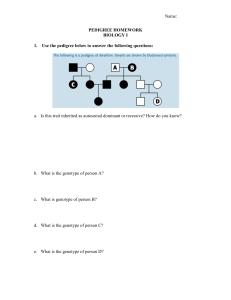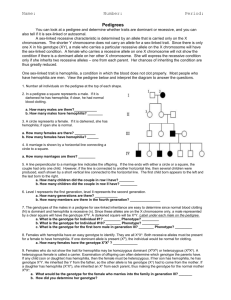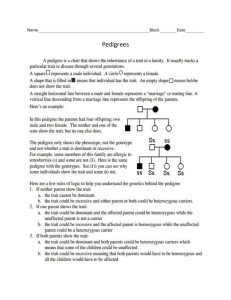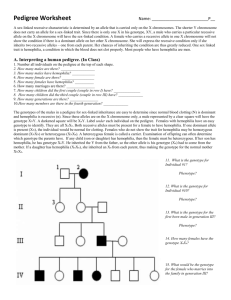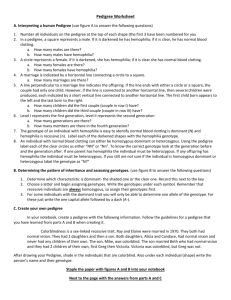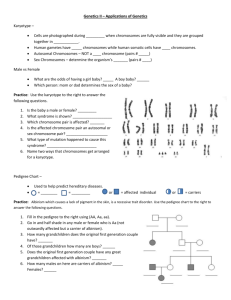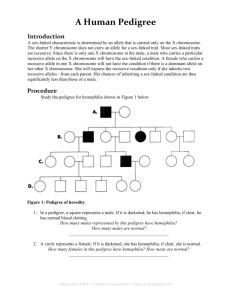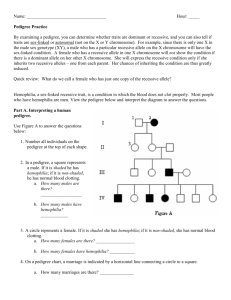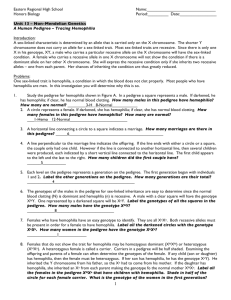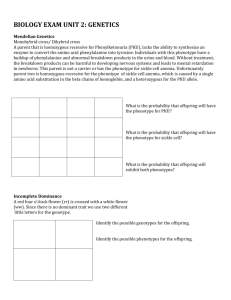Sex Linked Pedigrees 1 - Christopher-Bio6
advertisement
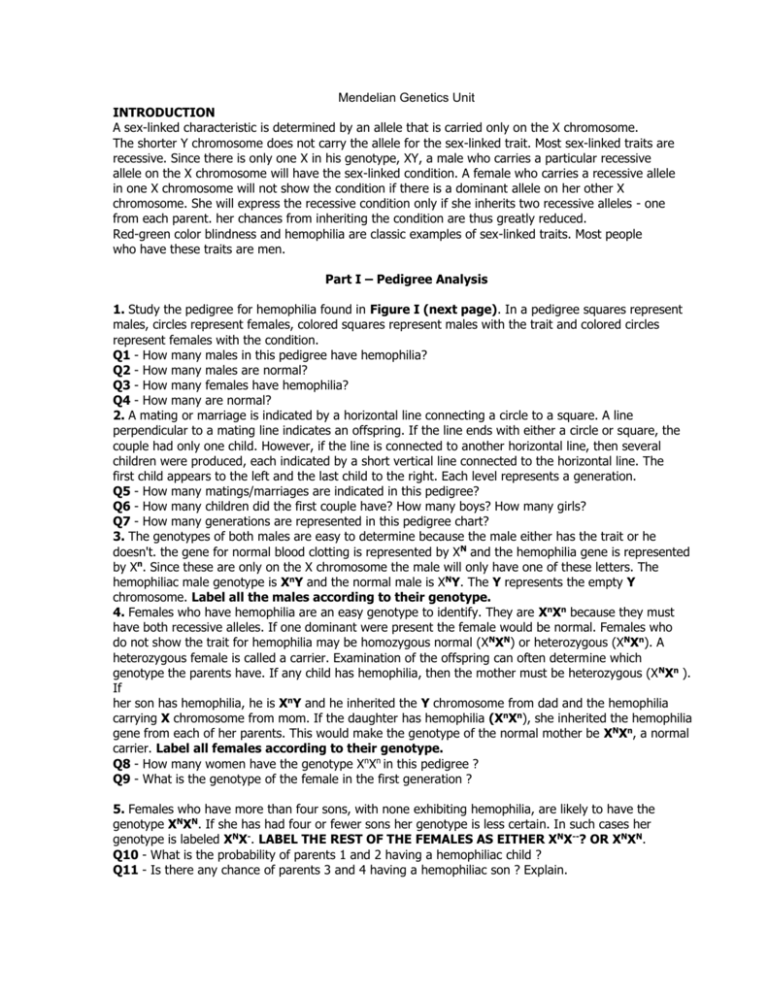
Mendelian Genetics Unit INTRODUCTION A sex-linked characteristic is determined by an allele that is carried only on the X chromosome. The shorter Y chromosome does not carry the allele for the sex-linked trait. Most sex-linked traits are recessive. Since there is only one X in his genotype, XY, a male who carries a particular recessive allele on the X chromosome will have the sex-linked condition. A female who carries a recessive allele in one X chromosome will not show the condition if there is a dominant allele on her other X chromosome. She will express the recessive condition only if she inherits two recessive alleles - one from each parent. her chances from inheriting the condition are thus greatly reduced. Red-green color blindness and hemophilia are classic examples of sex-linked traits. Most people who have these traits are men. Part I – Pedigree Analysis 1. Study the pedigree for hemophilia found in Figure I (next page). In a pedigree squares represent males, circles represent females, colored squares represent males with the trait and colored circles represent females with the condition. Q1 - How many males in this pedigree have hemophilia? Q2 - How many males are normal? Q3 - How many females have hemophilia? Q4 - How many are normal? 2. A mating or marriage is indicated by a horizontal line connecting a circle to a square. A line perpendicular to a mating line indicates an offspring. If the line ends with either a circle or square, the couple had only one child. However, if the line is connected to another horizontal line, then several children were produced, each indicated by a short vertical line connected to the horizontal line. The first child appears to the left and the last child to the right. Each level represents a generation. Q5 - How many matings/marriages are indicated in this pedigree? Q6 - How many children did the first couple have? How many boys? How many girls? Q7 - How many generations are represented in this pedigree chart? 3. The genotypes of both males are easy to determine because the male either has the trait or he doesn't. the gene for normal blood clotting is represented by XN and the hemophilia gene is represented by Xn. Since these are only on the X chromosome the male will only have one of these letters. The hemophiliac male genotype is XnY and the normal male is XNY. The Y represents the empty Y chromosome. Label all the males according to their genotype. 4. Females who have hemophilia are an easy genotype to identify. They are XnXn because they must have both recessive alleles. If one dominant were present the female would be normal. Females who do not show the trait for hemophilia may be homozygous normal (XNXN) or heterozygous (XNXn). A heterozygous female is called a carrier. Examination of the offspring can often determine which genotype the parents have. If any child has hemophilia, then the mother must be heterozygous (X NXn ). If her son has hemophilia, he is XnY and he inherited the Y chromosome from dad and the hemophilia carrying X chromosome from mom. If the daughter has hemophilia (XnXn), she inherited the hemophilia gene from each of her parents. This would make the genotype of the normal mother be XNXn, a normal carrier. Label all females according to their genotype. Q8 - How many women have the genotype XnXn in this pedigree ? Q9 - What is the genotype of the female in the first generation ? 5. Females who have more than four sons, with none exhibiting hemophilia, are likely to have the genotype XNXN. If she has had four or fewer sons her genotype is less certain. In such cases her genotype is labeled XNX-. LABEL THE REST OF THE FEMALES AS EITHER XNX--? OR XNXN. Q10 - What is the probability of parents 1 and 2 having a hemophiliac child ? Q11 - Is there any chance of parents 3 and 4 having a hemophiliac son ? Explain. Figure I – Hemophilia Pedigree 6. Label the genotypes of the individuals found in the pedigree in Figure II. Part II – Royal Families of Europe Case Study 1. First, let’s take a look at Queen Victoria’s son Leopold’s family. His daughter, Alice of Athlone, had one hemophilic son (Rupert) and two other children—a boy and a girl—whose status is unknown. Q12 - What is the probability that her other son was hemophilic? Q13 - What is the probability that her daughter was a carrier? Hemophilic? Q14 - What is the probability that both children were normal? 2. Now for the Spanish connection: Victoria’s youngest child, Beatrice, gave birth to one daughter, one normal son, and two hemophilic sons. Q15 - Looking at the pedigree of the royal family, identify which of Beatrice’s children received the hemophilic gene; why can you make this conclusion? Notice that Beatrice’s daughter, Eugenie, married King Alfonso XIII of Spain and had six children, one of whom was the father of Juan Carlos, the current King of Spain. Would you predict that Juan Carlos was normal, a carrier, or a hemophilic? 3. Alexis did not die from hemophilia. At the age of fourteen he was executed with the rest of the family. His four oldest sisters were also young and didn’t have children, so we don’t know whether any of them was a carrier. But we can make an estimate. Q16 - What are the probabilities that all four of the girls were carriers of the allele hemophilia? Q17 - Supposing Alexis had lived and married a normal non-carrier woman, what are the chances that his daughter would be a hemophiliac? Q18 - What are the chances his daughters would be carriers? Q19 - What are the chances that his sons would be hemophiliacs? 5. Prince Charles is the designated next king of England. His well publicized marriage to Princess Diana produced two sons before it ended in an acrimonious divorce. Q20 - If you learned that one of the two was a hemophiliac, what are the possible explanations for this event? Figure III –Royal Families of Europe Pedigree
